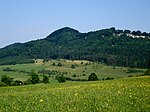Zollernalbkreis
Districts of Baden-WürttembergTübingen (region)Zollernalbkreis
The Zollernalbkreis is a Landkreis (district) in the middle of Baden-Württemberg, Germany. The district is located in the Swabian Alb, and contains the second highest elevation of this range, the 1,011-metre (3,317 ft) high Oberhohenberg. In the south-east the district nearly reaches to the river Danube. The district was created on January 1, 1973, when the two previous districts Balingen and Hechingen were merged. Neighboring districts are (from north clockwise) Tübingen, Reutlingen, Sigmaringen, Tuttlingen, Rottweil and Freudenstadt.
Excerpt from the Wikipedia article Zollernalbkreis (License: CC BY-SA 3.0, Authors).Zollernalbkreis
Sommersteigweg, Gemeindeverwaltungsverband Bisingen
Geographical coordinates (GPS) Address Nearby Places Show on map
Geographical coordinates (GPS)
| Latitude | Longitude |
|---|---|
| N 48.283333333333 ° | E 8.9333333333333 ° |
Address
Sommersteigweg
Sommersteigweg
72406 Gemeindeverwaltungsverband Bisingen (Gemarkung Bisingen)
Baden-Württemberg, Germany
Open on Google Maps







